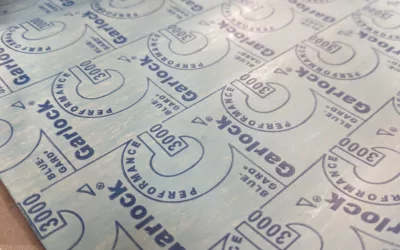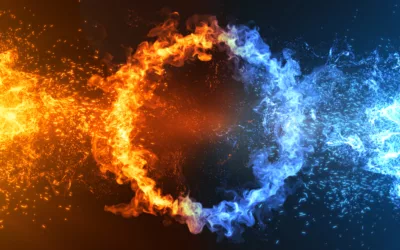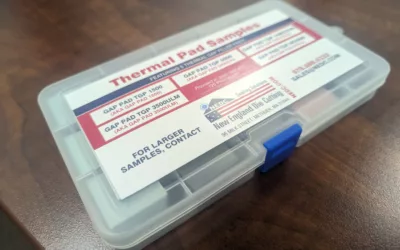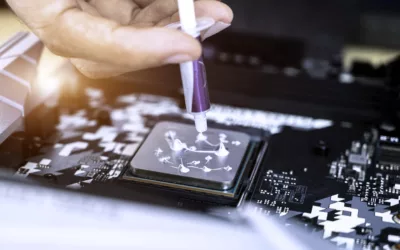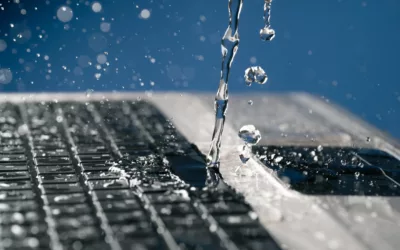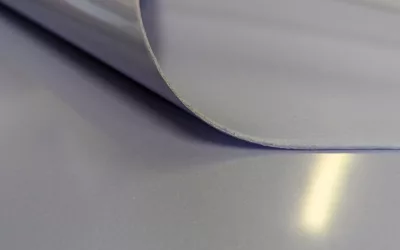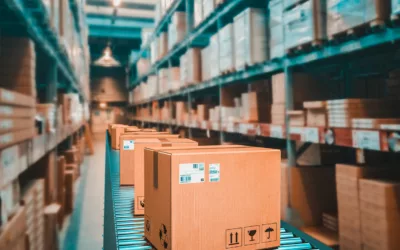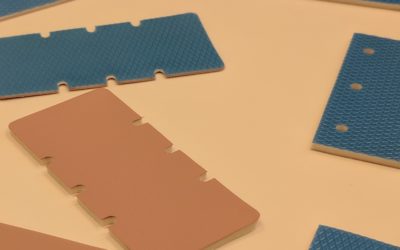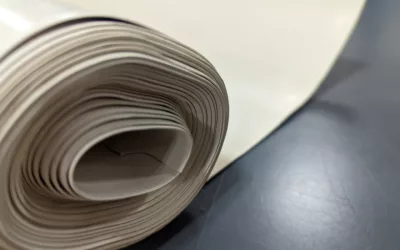Waterjet Cutting
Foam, Solid Gaskets, Thermal Pads, Absorbers, and Electrical Insulators
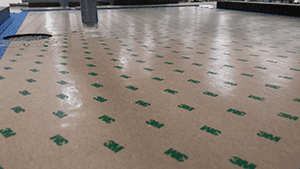
Waterjet Cutting PSA-backed Neoprene Gasket
NEDC operates only with state-of-the-art equipment that can handle a wide variety of materials. One of the most sophisticated machines NEDC owns is our Waterjet Cutters. Waterjet Cutting happens through a very unique process. The process starts with a high-powered pump that creates a lot of pressure for the water. The water then exits the head of the waterjet through a premounted sapphire/diamond orifice. All of this action produces an extremely powerful waterjet stream that is forced from the head at incredible speeds, (30,000-50,000psi). This streams pierces the gasketing material creating a clean cut with the most available commodity on the planet, water. The waterjet cutting process allows parts to be nested in a very economical fashion. NEDC is a leading waterjet cutting supplier for gaskets, insulators, and other elastomeric products such as thermal filler pads, or absorbers.
Foam/Sponge Gaskets:
Foam or Sponge gaskets are also cut with our waterjet machine. These materials can be flexible and cause issues in conventional die-cutting. This is due to the elastic nature of these materials; causing the material to snap-back into an hourglass like shape. However, with a waterjet focusing on one hole/feature/cut at a time, meeting tolerance requirements becomes easier.
Solid Rubber Gaskets:
At NEDC, the main function of our waterjet is used to cut solid gaskets. These gaskets can range from nitrile rubber, to neoprene rubber. The reason we do this is because typically when our customer is looking for a few gaskets, we can make them quickly and accurately on our waterjet. It also helps us dial in tight tolerances. Some of these materials include neoprene, fluorosilicone, silicone, nitrile, EPDM, or other conventional rubber materials.
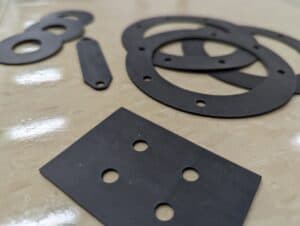
butyl custom gaskets
Advantages of a Waterjet Cutting Machine:
- Extremely Accurate Cuts of Complex Parts
Waterjet cutting offers an incredible amount of accuracy through a coordination of computer software and tight controls. Tolerance can be held as +/- .002” on some materials.
- Maximizes Yield of material through nesting software
Parts can be easily nested to offer our customer the best price possible. In some situations, when a part has a very unique geometry, sometimes the way it may be nested is not quite as linear as a simple horseshoe like part. In these cases, waterjet machines are able to flip, turn, and match the shape in many different directions utilizing every inch of material.
- No tool investment is necessary for water jet cutting
No tool is needed to be made, the DXF is the tool! Please provide an electronic file to aid in programming/cutting. This saves time and money because this file is cut to your specifications.
- Quick Prototypes
At NEDC, we strive to provide prototypes quickly. Waterjet Cutting offers the advantage of the customer being able to engineer the part through their DXF and see what the part will look like in production. The benefit of creating a DXF gives a side benefit of being able to move into production in a much quicker fashion by reducing the time between each prototype rendition. No tool is required to be created, so parts can be cut extremely fast.
- Cut parts from CAD/DXF files, to ensure perfect accuracy of every cut, every time. High degree of repeatability
The DXF is executed by the software in the waterjet cutting machine. When cutting with a DXF file, you can guarantee that no tool will wear/abrade. The waterjet stream itself is always offering a consistent water stream that makes each part nearly identical to the last. This makes reproducibility a huge asset for the machine.
- Allows materials to be cut without the typical compression of conventional die-cutting
Die-Cutting thick foam/sponge materials can result in concavity because of the “burst” action of the die; with a waterjet it is possible to avoid this compression distortion because the waterjet is not compressing the material in the way a conventional die cutting operation would. The difference is, it is slicing through the material in a vertical direction.
- Size of gaskets/parts has little limitations
Cutting gaskets has nearly no limitations when it comes to custom. However, size becomes a concern the bigger the gasket becomes. With waterjet cutting, the only limitation becomes the size of the bed of the waterjet itself. With that said, NEDC has cut 7 foot gaskets before on its waterjet machine.
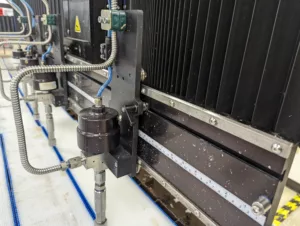
waterjet cut sponge/foams
Limitations of a Waterjet Cutting Machine:
- Size of parts have limitations
While we just said above that bigger gaskets are easier to cut with a waterjet- as it gets smaller, it may become more difficult. This is because the waterjet stream has a size too, and that starts to limit the features it can cut with accuracy. If the stream and the feature become competitive in size, it can become a challenge.
- Amount of parts being cut
While waterjet cutting is pretty quick, the amount of parts being cut can become a challenge because as mentioned above, cutting with a waterjet only works on one feature at a time. This is in comparison to die-cutting that cuts everything all at once. This is one of the tradeoffs when using a waterjet cutting machine. This drawback generally falls under speed of the overall process.
- Some materials just do not work
Some materials just do not cut well on a waterjet. Fibrous, or otherwise paper like products generally have a tough time cutting because either they soak up the water or they explode when cutting them. Other materials that we know do not work is anything that is impregnanted with wire in a perpendicular direction to the material. It is wise to consult with an experienced waterjet operator before asking a part to be waterjet.
If you have a gasket/part that you believe could be waterjet cut, please send your question or drawing to sales@nedc.com. NEDC has experienced waterjet operators that understand what the machine can do well.
Waterjet Cutting Blog
NEDC Launches Video Demonstrating How Thermal Pads Work!
<iframe width="1519" height="526" src="https://www.youtube.com/embed/Z5l5bvd-4CE" title="How do Thermal Interface Pads/Thermal Gap Fillers Work? A Demo!" frameborder="0" allow="accelerometer; autoplay; clipboard-write; encrypted-media; gyroscope;...
Previous Posts
Thin Gasketing Options | .015”, & Below | High Performance Gaskets
Applications get smaller, and smaller everyday. As footprints of the...
T-Global Technology | Thermal Gap Pads | Thick, Thin, High W/m-K
At NEDC, thermal pads are our specialty. Our manufacturing site is in...
EMI/RFI Bulb/Hollow Gaskets – The Softest EMI/RFI Gasket
At NEDC, we mostly die-cut, knife-cut, or waterjet cut gaskets. However,...
Garlock BLUE-GARD Gasketing Options | Waterjet/Die-Cutting
At NEDC, engineered options are our thing. In this blog, we wanted to discuss all of the Garlock options that are under the BLUE-GARD® brand. These materials are non-asbestos, aramid fiber gaskets that are compressed with different binders. Popular Garlock BLUE-GARD®...
R10400M (Medium) Flame Retardant Silicone Sponge | Custom Die-Cut Parts
Silicone Sponge, and Silicone Foam are different. I’ve talked about that in another blog on our website. Both have desirable properties. Some have good physical properties, and some have good flame retardant properties. There are some products that can actually be...
Thermal Pad Tackle Box | Sales Tool for Testing/Sampling
At NEDC, we are all about thermal. We enjoy making new sales tools to help customers design thermal interface pads into their applications. Why use this Sales Tool? This thermal pad tackle box allows the user to try different thermal pads. In this kit, we have 5...
Thermal Pad vs. Thermal Grease/Mica
One common question I hear engineers ask about is if it's better to have Mica/Grease or Sil-Pad products. Obviously, I’m partial to this, but I wanted to give some thoughts I had about Mica/Grease, and why I think it has its place, but why I think in a manufacturing...
IP Ratings – Gaskets & Ratings | Particles/Liquid Ingress
IP (Ingress Protection or International Protection) ratings are a common way to define how protected an electrical enclosure is from foreign matter that does not belong in the said enclosure. Gaskets are frequently used to provide the protection set forth in this...
TFLEX 600 | High-Compliance Thermal Pads | Low-Stress
NEDC manufactures thermal pads for many different customers. The thing I love about thermal pads, there is so many of them. Each one has different properties, and has its own fit for applications. Properties of TFLEX 600 Thermal Pad TFLEX 600 is a boron nitride...
Passivated Silver Aluminum EMI Gaskets | Custom Cut Gasket
NEDC manufactures gaskets of all sorts. Our arena of play in the gasket world usually is high value gasketing materials. For that reason, a lot of the build to print items we see include “SILVER FILLED” or “SILVER - COPPED FILLED” A question we get very often, is...
Engineering Note: Hole Diameters: How low can you go?
At NEDC, cutting gaskets is what we do. Gaskets typically have holes in them to provide room for screws or bolts to go through them in order to provide pressure, and then for that reason, also to provide compression for the gasket to seat/seal properly. How small is...
Liners for Die-Cutting – Why is there Thick, or Thin Liners?
NEDC is an authorized converter for 3M company. For that reason, we often get questions from customers about the adhesive tape products we offer. Customers often ask, what is the difference between this tape, and this tape? The reason customers ask this question, is a...
Tips/Tricks to Avoid Supply Chain Disruptions | Custom Die-Cutters
In this supply chain taxed environment, I thought I’d write a blog about how to keep your supply chain moving at the maximum speed possible- whatever that may be nowadays. In this blog, we will provide some tips, and tricks to keep your supply chain moving....
Why so many Gap Pads/Thermal Pads? Some Thoughts
I often get the question, “Why are there so many thermal pads?” In addition, I always joke there are so many types of thermal pads, that they are sort of like ice cream flavors. There is a type of ice cream for everybody. Some Thoughts I had on "Why so Many Gap...
FDA, 21 CFR 177.2600 Gasketing Materials | Neoprene, Nitrile, FKM, EPDM
About 8 years ago, when I had first started blog writing- oh God, don’t remind me it was 8 years ago, I wrote a blog on FDA Gaskets for silicone rubber products. This blog only covered what was available for silicone rubber products. In that blog, we neglected rubber...
All of the information presented above is believed to be factual and accurate; however, NEDC is not liable for any design or application utilizing this information.
New England Die Cutting
Capabilities/Products
Quick Links
Popular Blog Posts
Can you use a Thermal Pad/Gap Pad more than Once?
My blogs largely originated from the various questions I have gotten from customers over the years. This includes the most popular ones. One question I realized I get an awful lot is : “Are Gap Pads Reusable?” Heres my short answer, “It depends, but I wouldn’t ever”....
Die-Cutting vs Laser Cutting, Epoxy Preforms: Part 2
I had a customer call the other day, saying he heard that laser cutting was better than die-cutting for frozen epoxy preforms. Heres the thought I had in my head “Why does this keep coming up!?” Heres my thought, and then I’m going dive into every advantage, and...
Super-Soft Silicone Rubber Gaskets | Tight-Tolerance/High-Temperature
At NEDC, Custom Silicone Rubber Gaskets are a common product we sell. Included in that category are the Super-Soft Silicone Rubber Gaskets that are available. When I think soft gaskets, typically below 40A durometer would be considered soft. However, when I think of...
